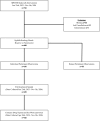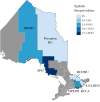Intersecting Risk Factors Associated With High Syphilis Seroprevalence Among a Street-Involved Population in Canada
- PMID: 40852137
- PMCID: PMC12368418
- DOI: 10.1093/ofid/ofaf472
Intersecting Risk Factors Associated With High Syphilis Seroprevalence Among a Street-Involved Population in Canada
Abstract
Background: Syphilis has reemerged as a global public health concern. In Ontario, Canada's most populous province, a 340% increase in infectious syphilis cases was observed between 2013 and 2023. This surge was accompanied by a demographic shift, with women emerging as the fastest-growing at-risk group. We examined intersecting risk factors associated with syphilis seropositivity among a street-involved population.
Methods: Data were collected from the Syphilis Point of Care Rapid Test and Immediate Treatment Evaluation (SPRITE) study-an outreach model of care implemented by 8 public health units (PHUs) across Ontario between 2023 and 2024. Reactive treponemal antibodies defined syphilis seroprevalence. A mixed-effects regression with a log-binomial distribution was used to evaluate the association between risk factors and seropositivity. Adjusted prevalence ratio (aPR) controlled for age and sex and clustering by PHUs.
Results: A total of 630 participants, 42% women, with a median age of 38, were included; 19.1% of participants reported having sexual risk factors, using illicit drugs, and being un(der)housed. Overall, syphilis seroprevalence was 7.6% (95% confidence interval 5.5-9.7), with significant heterogeneity across the province and higher among those reporting 3 risk factors (19.2% [11.2-29.7]) compared with 1 risk factor (4.8% [1.8-10.1]). Seropositivity was higher among women (aPR 1.62 [.94-2.80]) and people who use illicit drugs (aPR 2.30 [.93-5.50]), particularly those who use crystal methamphetamine (aPR 2.88 [1.31-6.33]).
Conclusions: Syphilis is heightened at the intersection of sexual risk factors, illicit drug use, and housing instability among equity-deserving populations. Targeted outreach models of care are necessary to reach this emerging at-risk population.
Keywords: people who are unhoused; people who use drugs; seroprevalence; street-involved population; syndemic; syphilis; women.
© The Author(s) 2025. Published by Oxford University Press on behalf of Infectious Diseases Society of America.
Conflict of interest statement
Potential conflicts of interest. S. S. has a perceived conflict of interest; she received an honorarium from Novo Nordisk as an advisory board member (unrelated to this study). All other authors declare: no support from any organization for the submitted work; no financial relationships with any organizations that might have an interest in the submitted work in the previous 3 years; no other relationships or activities that could appear to have influenced the submitted work.
Figures



References
-
- Ontario Agency for Health Protection and Promotion (Public Health Ontario) . Infectious syphilis and early congenital syphilis in Ontario: focus on 2023. Toronto, ON: Public Health Ontario, 2025. Available at: https://www.publichealthontario.ca/-/media/Documents/S/25/syphilis-ontar.... Accessed February, 2025.
-
- Ontario Agency for Health Protection and Promotion (Public Health Ontario) . Infectious disease trends in Ontario: syphilis, infectious. Toronto, ON: Public Health Ontario, 2025. Available at: https://www.publichealthontario.ca/en/Data-and-Analysis/Infectious-Disea.... Accessed February, 2025.
-
- Ontario Agency for Health Protection and Promotion (Public Health Ontario) . Infectious syphilis and early congenital syphilis in Ontario: focus on 2022. Toronto, ON: Public Health Ontario, 2024. Available at: https://www.publichealthontario.ca/-/media/Documents/S/2023/syphilis-ont.... Accessed February, 2025.
-
- Aho J, Blair A, Lybeck C, et al. Syphilis in Canada, technical report on epidemiological trends, determinants and interventions. Ottawa, ON: Centre for Communicable Diseases and Infection Control, Public Health Agency of Canada, 2020. Available at: https://www.canada.ca/content/dam/phac-aspc/documents/services/publicati.... Accessed February, 2025.
LinkOut - more resources
Full Text Sources
Miscellaneous

